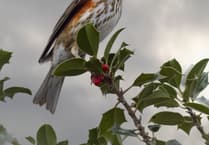.jpeg?width=752&height=500&crop=752:500)
Millions of birds are on the move – and they’re coming to the UK!
While we may regret the arrival of cooler and damper autumnal weather after the hot, sunny and dry summer, our mild temperate climate and varied coastline makes the UK a magnet for millions of birds.
Birds migrate to take advantage of seasonal resources, especially food, so that they can breed successfully or simply survive. Some migrations are short, but many birds make epic journeys, crossing continents, deserts and oceans.
While summer visitors such as swallows, swifts and cuckoos are leaving us, many bird species are arriving to overwinter here.
The RSPB bird charity has posted an autumn arrivals board so we can see what birds to expect and when: visit rspb.org.uk/birds-and-wildlife/autumn-arrivals
It says that our coastal estuaries, saltmarshes and inter-tidal wetlands are a winter hotspot for hundreds of thousands of wading birds. Other species will be overwintering inland. These include the redwing, which we often see locally in good numbers.
The RSPB explains that redwings migrate at night and that it’s possible to hear them during their migration! It says they "can be heard pretty much anywhere in the UK from October. Just head outside and listen out for their high-pitched ‘tseep’ migration call.”
Another arrival is the waxwing, any time from October to January, but the RSPB adds that whether they visit us depends on the berry harvest in Scandinavia; a bad harvest there could mean flocks of these hungry berry-eaters turn up here in what’s known as an irruption.
Among the hundreds of thousands of ducks flying to the UK is the mallard, swelling the ranks of our resident populations on lakes, reservoirs and any decent-sized pond.
I was surprised and fascinated to learn from the RSPB that while we have around 61,000 breeding pairs in the UK, the numbers rise to around 675,000 birds as thousands arrive from France, the Netherlands, Finland, Russia and the Baltic states.
Another arrival is the wigeon. The UK has a breeding population of only around 200 pairs, but the overwintering population is around 450,000 birds as huge numbers migrate from Iceland, Scandinavia and Russia. Look for them in flocks, often grazing in fields close to water, as well as on large lakes, reservoirs and other wetland and coastal areas.
The teal is another duck to look out for in winter, with thousands flying in from Russia and the Baltic states. These are the UK’s smallest duck, often found in quiet corners of lakes and marshes.
Did you know there are two World Migratory Bird Days, celebrated this year on 10 May and 11 October, marking the two peak periods when migrating birds fly between their winter and summer homes? It was news to me – but it seems every day of the year is an awareness or celebration day for various things!
World Migratory Bird Day (www.worldmigratorybirdday.org) is an annual awareness-raising campaign highlighting the need for the conservation of migratory birds and their habitats. The 2025 theme, “Shared Spaces: Creating Bird-Friendly Cities and Communities”, addresses challenges including habitat loss and threats including bird collisions, light pollution and bird deaths caused by free-roaming pets.
Give a silent cheer for any of the birds you spot that have taken on the twice-yearly migration – it’s a remarkable feat!
.jpeg?width=752&height=500&crop=752:500)




Comments
This article has no comments yet. Be the first to leave a comment.